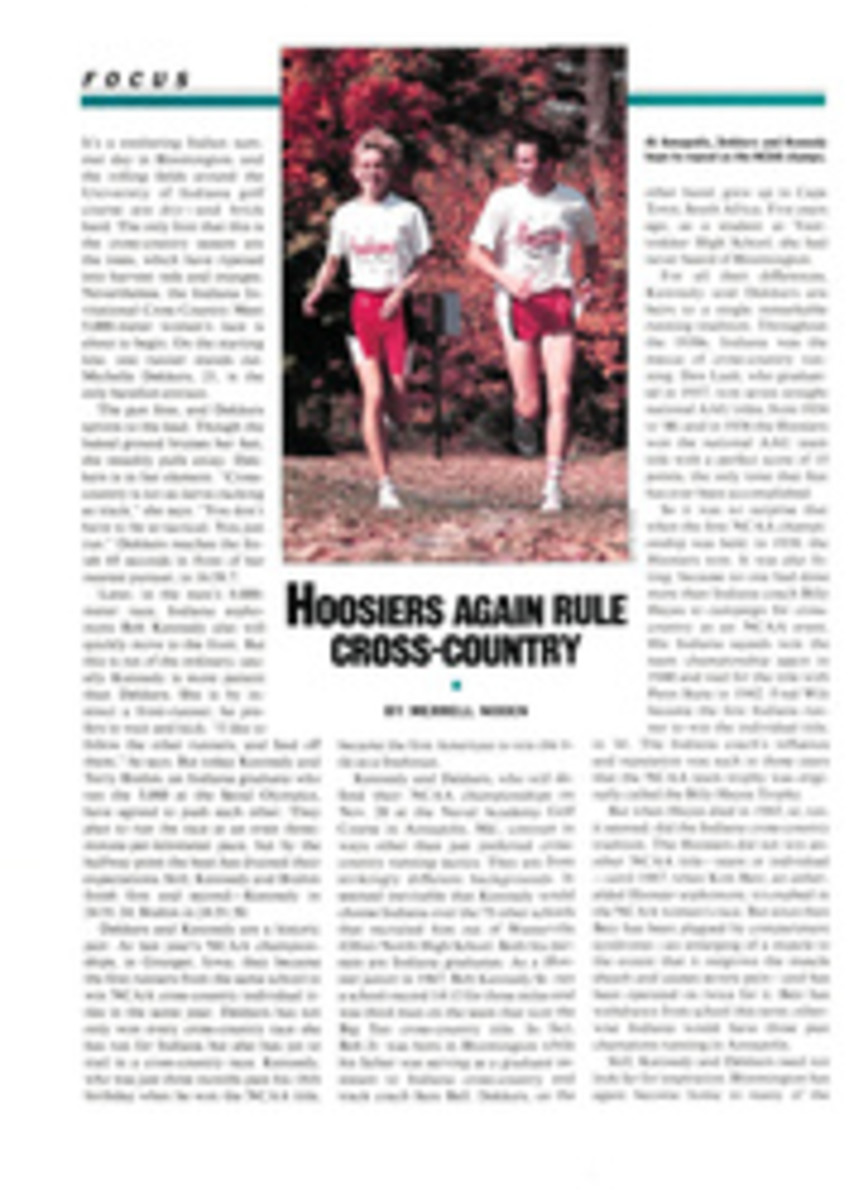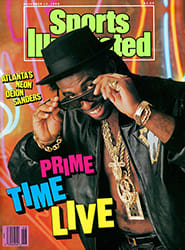
THE BIG, BAD BLUE BULLIES
New York giants coach Bill Parcells looks into the future, and what he sees is a solid wall of 290-pound linemen pounding defenders into submission, with a 225-pound tailback banging away behind them. He sees an offense with three tight ends and a quarterback who throws only enough to remind people that he's on the field. Parcells scans the stat sheet, and his finger stops at one number—time of possession.
"Here, look at this," he said after the Giants beat the Cardinals 20-13 in Phoenix to raise their record to 8-1, best in the NFL, though the San Francisco 49ers were in a position to match it by beating the New Orleans Saints on Monday night. "We controlled the ball for 38 minutes and 10 seconds. If we're not Number One in the league in time of possession now, we're close to it."
No other team this season has called as many running plays or thrown fewer passes. The ratio against the crippled Cards, who performed miracles by even making the game close, was 48 runs to 25 pass plays. O.J. Anderson did most of the ground work for New York, carrying 27 times for 89 yards. The Giants threw only five passes in the second half, which began with them sitting on a 14-3 lead. For the game, they ran on 25 of 27 first downs (aside from two-minute situations), including all 12 in the second half. They even ran when Phoenix went to a nine-man defensive front—four linemen and five linebackers—making the game look like something out of the 1930s.
O.K., you could say it made sense for New York to keep the ball on the ground because the Cards' defensive line was light and undermanned and because the Giants were playing without No. 1 quarterback Phil Simms, who was resting a sprained ankle. But the reasoning goes deeper than that. It's part of Parcells's long-range plan, which he began to implement two years ago, when New York drafted two oversized offensive linemen, 290-pound Eric Moore and 6'7", 305-pound Jumbo Elliott, in the first two rounds. This year the Giants added another pair of offensive biggies, 300-pound Brian Williams and 288-pound Bob Kratch, to their first two choices.
"I knew the game was changing, especially this year," says Parcells. "There are too many multiple defenses nowadays, too many different fronts. You can't run eight different schemes against eight different fronts. It's too difficult to practice. You're better off just lining up with your big guys and pounding away, and then stretching the defense by throwing downfield. I knew the game would come to this someday, and I started preparing for it."
"No defensive lineman is going to tell you he enjoys lining up against Jumbo Elliott, toe-to-toe, and playing the run block all day," says Giants defensive end Leonard Marshall, who has to face Elliott in practice every day.
New York's wideouts—Lionel Manuel, Odessa Turner, Mark Ingram, Stephen Baker—are merely role players. None of them has had a 100-yard day this year, and no Giants receiver is among the league's top 50 in catches. New York's second touchdown on Sunday came on a 35-yard crossing pattern from Jeff Hostetler to Baker. The catch was Baker's fourth of the year.
And what about Simms, who pulled rabbits out of a hat during the Giants' Super Bowl-winning season of 1986? Remember all those come-from-behind heroics, like the 22-yard completion on fourth-and-17 that set up a field goal to beat the Minnesota Vikings 22-20? And his near-perfect performance—22 completions in 25 attempts—in the Super Bowl itself? How does he see his place on this team? "All I want to do is play my role," he says.
Yeah, but how does he like merely being the guy who hands the ball off to Anderson and throws only when he has to? "I like being 8-1," he says with a smile. "Make that, I love it.
"Look, Coach Parcells has great football instincts. He has a formula for how to win. It doesn't please a lot of people. It's not pretty, and the genius types won't like it. But it's very solid. Play hard, have good special teams and a good defense, don't turn the ball over.
"We've controlled the pace of every game by doing things the way we wanted. I think back to 1985. God, we were throwing the ball, really stretching it. It was almost hilarious. I threw for 432 yards one week, 513 the next—and you know something, we lost both games.
"This year, when we beat the Vikings on Monday night [Oct. 30], the first thing Coach Parcells said to us after the game was 'Hah—42 runs, 14 passes.' We didn't gain a whole lot of yards, but we ran the ball. The only game in which we threw more than we ran was against Philadelphia [Oct. 8]—our only loss."
All this makes for a neat story—the meat grinder Giants, who bully everyone. Then there's the part about Anderson, whose 31-year-old legs found new life when first-string tailback Joe Morris went down with a foot injury in the final exhibition game. With his 89 yards on Sunday, Anderson ran his season's total to 698, third in the NFC. But there's a downside, too.
A massive, area-blocking offensive line sounds impressive; the Giants average 283 pounds, tackle to tackle. But mobile, quick-footed defensive lines traditionally give that type of unit trouble, and the Vikings, with their stunting and speedy rushers, did just that two weeks ago. They sacked Simms and Hostetler five times, knocked Simms out of action and were agile enough to pick up the run on the go. When the Vikings ran their their end-tackle games, New York's ponderous blockers had trouble picking them up. Someone always came free.
The Giants ran the ball a lot in that game, but their total offensive production was a measly 174 yards. They won 24-14 thanks largely to an interception that was returned for a touchdown and to two Minnesota fumbles on kickoff returns. What happens the next time New York faces a team like that, say the Rams in L.A. this Sunday, the 49ers later in the month, or the Vikings again in the playoffs? What happens if the Giants fall behind and have to play catchup? "First you have to get us in that position," says Simms. "So far, nobody has."
Well, almost nobody. New York had to come back at the end to beat the Washington Redskins in their season opener. Simms, a master of the two-minute offense, took the Giants down the field in the last 44 seconds for the winning field goal. When New York trailed the Detroit Lions 14-3 in the third quarter the next week, they had to open it up a bit to get back in the game.
"You never know what's going through Coach Parcells's mind," says Simms. "When we played at Washington in our Super Bowl year, he told us, 'Let's throw it a little.' He just made the decision that we would have to throw to beat them. It came out of nowhere."
An upside to New York's ball-control offense is that its defense gets lot of breathing time. In 1986 the Giants defense ranked second in the league. It was the Beast of the East, a crushing, stifling monster that buried offenses. Last year, when the Giants finished 10-6 and missed the playoffs, the defense dropped to 11th. Now it's back. Going into the game against Phoenix, in which the Giants gave up only 186 yards, the defense was sixth in the NFL.
"We don't have the stars we had on that Super Bowl team, guys like Harry Carson, Jim Burt and George Martin," says linebacker Lawrence Taylor. "We have a bunch of guys who are just hard workers, guys who want it. It's as simple as that. All you need to have is people who want to get it done."
Taylor has had a renaissance this year. For a while he looked to be wearing down under the constant double-and triple-team pounding. But after getting three sacks against Phoenix, he's back among the leaders in that category, with 12 for the season. Two of Taylor's sacks on Sunday came on straight power rushes, one over tackle Luis Sharpe, who has always given him trouble, and one against Sharpe's replacement, Scott Dill.
A year ago Taylor was saying that his power rush wasn't what it once was. "It's back," he says now, "because I don't use it that often. You need it against a quick guy like Sharpe, but I've been speed rushing and making moves, so when I do come in with a power rush, it's effective, more effective than when I was young. All I did was power rush in those days."
The Giants have also improved their special teams with an influx of young talent. Reyna Thompson, a former Miami Dolphin cornerback and Plan B free agent who plays on the punting and punt-return units, is a good example. "He's the big reason I'm leading the league in net punting average," says Sean Landeta, referring to Thompson's pursuit of punt returners. "People don't get decent return yardage against us. I talked to Reggie Roby, the Dolphins' punter, when they lost Thompson. He was practically crying. He said, 'You're going to love this guy.' "
Well, the Giants are 8-1, and they're playing Parcells's brand of football. But the late-season crunch is coming, followed by the playoffs. That's when they'll need the change of pace.
PHOTO
JOHN BIEVER
...and by plowing through holes opened up by hulks like Elliott (76) and Bart Oates.
PHOTO
PETER READ MILLER
Anderson got 89 yards against the Cardinals by eluding tacklers on sweeps...
PHOTO
PETER READ MILLER
This 35-yard touchdown reception was only the fourth catch of the season for Baker.

